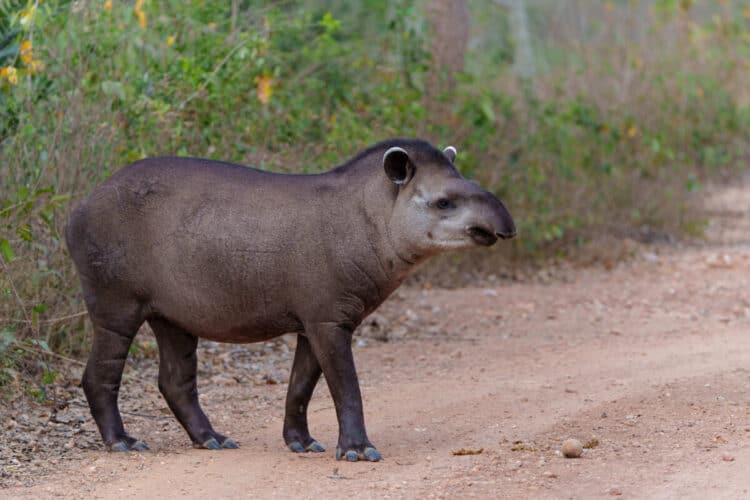The South American tapir (Tapirus terrestris) is a large herbivorous mammal found in the tropical rainforests of South America. It is the largest tapir species and plays a significant role in maintaining ecosystem balance.
This article provides a comprehensive overview of the South American tapir, focusing on its habitat and range, physical characteristics, diet and feeding habits, behavior and reproduction, conservation status and threats, as well as its importance to ecosystems.
The South American tapir inhabits diverse habitats including wetlands, forests, and grasslands across nine countries in South America. It has distinct physical features such as a barrel-shaped body with a short neck and trunk-like proboscis. The tapirs‘ diet mainly consists of leaves, fruits, grasses, and aquatic vegetation.
Understanding the behavior patterns and reproductive strategies of these animals is crucial for their conservation. Unfortunately, due to factors such as habitat loss, hunting for meat or hides, and fragmentation of their natural habitats; this species faces various threats that put them at risk of population decline.
This article aims to shed light on the conservation efforts being made to protect these animals from extinction while presenting an overall outlook for their future survival. By raising awareness about the importance of preserving this unique species within their ecosystems, it is hoped that effective measures can be implemented to ensure their long-term survival.

Habitat and Range
The South American tapir inhabits a range of diverse habitats across its distribution, including tropical rainforests, swamps, grasslands, and montane forests. This adaptability allows the tapir to survive in various environmental conditions.
In tropical rainforests, they can take advantage of the dense vegetation for cover and browse on a variety of plants.
In swamps, their elongated snouts enable them to reach submerged vegetation easily for feeding.
Grasslands provide open spaces for grazing on grasses and herbs.
Additionally, tapirs have been observed in montane forests at high altitudes. These habitats offer cooler temperatures and different plant species compared to lower elevations.
The South American tapir also interacts with other species within its habitat, such as dispersing seeds through consumption and defecation. This mutualistic relationship benefits both the tapir and the plants it feeds on by aiding in seed dispersal and germination processes.
Overall, these adaptations and interactions contribute to the survival strategies of the South American tapir in its diverse range of habitats.
Physical Characteristics
An examination of the physical characteristics reveals a distinct and unique morphology in the South American tapir. This species exhibits several adaptations that have evolved over its long evolutionary history. The tapir has a stocky body with short legs, allowing it to navigate through dense vegetation in its habitat. Its large, barrel-shaped torso provides buoyancy in water and aids in swimming. The South American tapir possesses a prehensile upper lip that helps it grasp leaves and fruits from trees, while its elongated nose is used for both smelling and breathing underwater. Additionally, this species has a distinctive coat pattern of dark brown or black coloration with white markings on the face, throat, chest, and limbs. These physical characteristics provide insights into the unique adaptations and evolutionary history of the South American tapir.
Table: Physical characteristics of the South American tapir.
Diet and Feeding Habits
Diet and feeding habits of the South American tapir reveal a specialized and diverse range of plant matter consumed. These herbivorous mammals exhibit varied foraging behavior, as they browse on a wide array of vegetation to meet their nutritional requirements.
The tapirs consume plants such as leaves, fruits, twigs, and bark from various tree species found in their habitats. Additionally, they also feed on aquatic plants like water lilies and grasses growing near rivers or swamps.
Their diet is supplemented with other plant materials like ferns, herbs, and even fallen fruits on the forest floor. By consuming this diverse range of plant matter, tapirs play a vital role in seed dispersal throughout their habitat.
This unique feeding behavior contributes to the overall health and diversity of the ecosystem they inhabit.
Behavior and Reproduction
Behavior and Reproduction of tapirs are fascinating aspects that contribute to the intricate dynamics of their ecosystems, inspiring awe in observers as they witness the intricate courtship rituals and the nurturing care provided by mothers to their young.
Tapirs are social animals, forming small groups consisting of a mother and her offspring or sometimes several females with their young. However, adult males are usually solitary and only join these groups during the mating season.
Mating rituals involve complex behaviors such as vocalizations, scent marking, and physical displays that serve to attract potential mates and establish dominance hierarchies among males. Once a female is receptive to mating, copulation occurs on land or in water.
Gestation lasts around 13 months, resulting in the birth of a single calf. The mother provides dedicated care for her offspring for up to 18 months before it becomes independent.
These behavioral patterns ensure successful reproduction and preservation of tapir populations within their habitats.
Conservation Status and Threats
The conservation status and threats faced by tapirs are crucial aspects that require immediate attention in order to ensure the long-term survival of these magnificent creatures. Tapirs have experienced significant population declines due to various factors, including habitat loss, hunting, and fragmentation of their natural habitats. Conservation measures are essential to mitigate these threats and protect tapir populations.
To illustrate the gravity of the situation, a table can be used to present data on tapir populations and their conservation status. This table could include information such as the estimated number of tapirs remaining in different regions, the level of protection provided by national parks or reserves, and ongoing conservation efforts.
Efforts to address these threats involve establishing protected areas, implementing sustainable land-use practices, promoting public awareness campaigns, and supporting research initiatives. Collaboration between governments, researchers, conservation organizations, and local communities is crucial for the successful implementation of these measures.
In conclusion, urgent action is needed to combat the population decline and implement effective conservation strategies for tapirs. By prioritizing their protection now, we can ensure the survival of this unique species for future generations.
Importance to Ecosystems
One crucial aspect to consider is the significant role tapirs play within their ecosystems, making their conservation vitally important.
Tapirs are key seed dispersers, promoting forest regeneration by consuming fruits and excreting intact seeds across their range. They have a diverse diet consisting of over 150 plant species, which contributes to maintaining biodiversity and ecosystem stability.
Additionally, tapirs play a vital role in population dynamics as they are preyed upon by large carnivores such as jaguars and pumas, regulating predator-prey relationships.
Furthermore, tapir dung serves as an essential nutrient source for many insects and smaller animals that inhabit the same ecosystems.
Therefore, protecting tapir populations is crucial for the ecological balance of South American forests and overall ecosystem health.
Conservation Efforts and Future Outlook
Conservation efforts for tapirs have been implemented to safeguard their populations and ensure their long-term survival. These efforts focus on habitat protection, reducing human-wildlife conflicts, and promoting awareness among local communities.
Tapirs are highly vulnerable to habitat loss due to deforestation and fragmentation caused by human activities such as agriculture and urbanization. To address this issue, conservation strategies aim to establish protected areas that encompass tapir habitats and create corridors connecting fragmented landscapes.
In addition to habitat protection, community involvement plays a crucial role in tapir conservation. Local communities are engaged through education programs and capacity-building initiatives to raise awareness about the importance of tapirs in maintaining ecosystem balance.
By involving communities in conservation efforts, there is a greater likelihood of achieving sustainable practices that benefit both the tapirs and the local people who rely on these ecosystems for their livelihoods.
